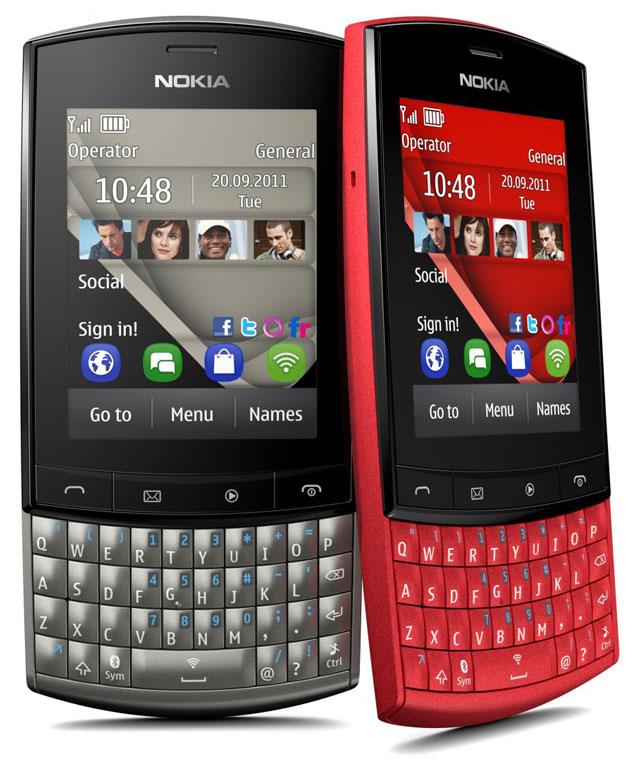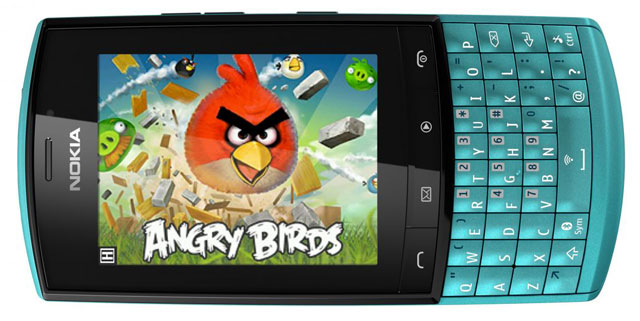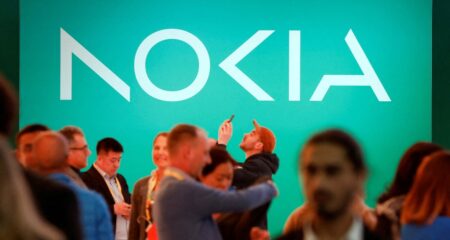
The Asha 303 is the flagship handset in Nokia’s feature-phone range and, considering its diminutive price and attractive design, it’s likely to do rather well with its target markets: the youth and those in emerging markets who want functionality without an enormous price tag.
Though it’s wrapped in plastic — with the exception of the alloy battery cover — the Asha 303 is made to look like its exterior is actually brushed metal. This, combined with the curved rear and Qwerty keyboard, makes for a device that is both comfortable in the hand and fairly easy on the eye.
Although it’s available in various colours, the gunmetal-grey version we reviewed could just as easily pass for a business user’s phone as it could for a student’s.
Weighing only 99g and at only 13,9mm thick, it’s lightweight and slim, yet the 2,6-inch display feels more than sufficient, and the fact that it offers capacitive-touch input in addition to the Qwerty keyboard makes it an incredibly easy phone to navigate. The screen resolution, however, is only 240×320 pixels, so it’s not going to be much good for multimedia content.
Running Nokia’s S40 platform, the Asha 303 offers a fairly intuitive menu layout and an interface that is devoid of clutter. The dedicated dial-pad, messaging, music and hang-up/power buttons beneath the screen make it even easier to use and hint at the youthful market at which it’s targeted.
The default shortcut icons on the home screen further reinforce this: there’s Nokia’s Internet browser (which the Finnish company claims compresses data by up to 90%), a built-in instant message application, messaging app WhatsApp and the Nokia Ovi Store.
Each shortcut can be replaced and there’s support for a swipe gesture shortcut in either direction. Swiping left on the shortcut bar brings up a photo gallery, while a swipe to the right opens the apps and games menus. Like the shortcuts, the swipe actions can be customised.
The screen is incredibly responsive, and although the haptic feedback — the feedback vibrations the phone emits when making selections — are a little jarring and crude, on the whole the user experience the Asha 303 offers belies the fact that its recommended retail price is only R1 799.

Unfortunately, it’s not possible or — given its size — practical to type using the touch screen. And the Qwerty keyboard requires a heavy hand. It’s also a little small, particularly if you’ve got large fingers. While the standard keys are marked in white, special characters are marked in blue and are difficult to see, though this may be less of an issue on handsets in other colours.
The camera is, as expected, pretty average at 3,2-megapixels and offers only 640×480 resolution video. At the price, though, that’s not surprising. It does offer a great deal of flexibility and control in terms of settings and should suffice for basic happy snaps. It won’t, however, be much good for anything beyond that.
Considering there’s only 100MB of on-board flash storage, it’s probably best the camera isn’t more impressive. That said, there is a microSD slot beneath the battery and this supports card sizes of up to 32GB, which is great for those wanting to listen to music on the device, and considering the target market, that should be most users.
Being an S40 handset, the selection of applications available for download is far more limited than those available for Android and Apple phones.
With a 1GHz processor, the Asha 303 is no slouch and is very responsive when flicking through menus or opening applications, even though it only includes 128MB of RAM.
Buttons are kept to minimum, with only a volume rocker and lock button on the right-hand side. Connectivity and output options on the top of the device include a 3,5mm audio jack, a micro USB port and a proprietary charging port. The last of these is something of an anomaly in an age where such chargers are becoming rare.
Nokia has decided to include its own charger but thankfully the handset can be charged using micro USB, too, so if you lost the the charger it wouldn’t be a problem. It does, however, make it even more peculiar that Nokia decided to include a proprietary charger at all.
On the whole, the Asha 303 is a capable device at a very reasonable price. It’s clearly targeting the same market as entry-level BlackBerry Curve devices but, with a less impressive keyboard and without the flat-rate data and e-mail offering BlackBerry provides, it’s hard to see why a teenager or student would opt for the Nokia over the Canadian equivalent. — (c) 2012 NewsCentral Media




